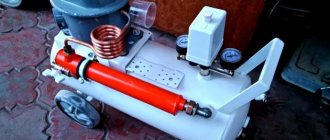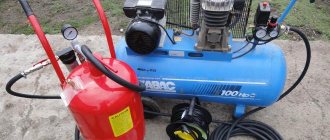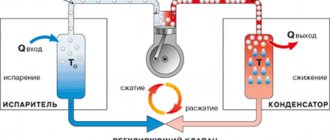An air piston compressor is one of the easiest devices to use, but at the same time it requires close attention to maintenance.
Proper care and operation will preserve the working life of the equipment and extend its life for many years. In almost 100% of cases, the first problems with the compressor arise due to a lack of experience in handling, ignoring the instructions and recommendations of the manufacturer. Most often, new owners complain about:
- Compressor shutdown after startup
- Lack of pressure to operate pneumatic tools
- Thermal protection triggered for unknown reasons
All this can be avoided - let's find out how to do it.
Preparing for work - first start-up of an air piston compressor
Instructions - always start with this. Even if you have extensive experience in handling compressor equipment, information about a specific model will not be superfluous. Beginners will benefit from a visual guide to the main processes, as implemented in the FUBAG instructions, and experienced users will benefit from recommendations on maintenance, selection of oil for a piston compressor, and operating nuances.
Let's move on to preparing the device:
1. If you have transport wheels, start by installing them after unpacking.
2. Check the oil level using a dipstick or eyelet.
3. There is not enough oil - add more. Enough - skip the point and move on to the next one.
4. Now you need to install the compressor correctly. Make sure that it stands on a flat surface to prevent uneven lubrication of the working elements. Will you be working indoors? Then it is worth maintaining a distance of half a meter from the device for free air flow to the compressor engine.
5. Install the air filter.
6. Install the breather (this is where the instructions for your compressor come in handy). 7. That's it, the device is ready for use.
Where would we be without precautions? Do you have to work outside? Then be sure to take care of protection from moisture.
So, the device is assembled, you can connect it to the mains and start:
1. Turn the pressure switch to the OFF position. 2. Check and close the air valve. 3. Connect power supply. 4. Turn the pressure switch to the RUN position.
The compressor will start working and maintain pressure, alternately reaching the upper and lower limits. The actual value is shown on the pressure gauge. To disable the automatic mode of alternating start and pause, simply turn off the pressure switch.
*You should wait at least 10 seconds before turning it on again.
Checking the car air conditioner for leaks
You can check the car air conditioner yourself for leaks not only when purchasing a car, but also if signs indicating this malfunction occur. A leak can be judged by the following signs:
- decreased air conditioning performance (the unit does not cool the air in the cabin enough);
- freezing of the external walls of the air conditioning system lines;
- the appearance of oil stains on the pipes of the air conditioning system.
If the level of freon in the system is critically low, it will be impossible to turn on the air conditioner, since the system will automatically turn it off based on data from the corresponding sensor.
How to check freon in a car air conditioner
The first step is to check the presence of refrigerant in the car air conditioner visually. The easiest method for monitoring the freon level in your air conditioner is to simply use the sight glass on the top of the receiver-dryer. It is specifically designed for visual monitoring of the presence and level of refrigerant.
In some cases, this peephole is simply covered with dirt and/or dust. Accordingly, it needs to be wiped with a rag.
To check freon, you need to start the engine and turn on the air conditioning at full power. After this, through the peephole mentioned above, you need to look at the condition of the freon. One of the situations described below is possible.
- Bubbles appear in the liquid , which disappear after a short time. Conclusion - the amount of freon is sufficient for normal operation of the air conditioner.
- Bubbles in the liquid initially appear in large quantities, but then they become smaller, but they DO NOT disappear completely. This means that freon is at a critically low level . Refueling required.
- Liquid freon has a milky white color, and there are always bubbles on its surface. Freon level is below the permissible norm . The air conditioner cannot be used until the system is charged with freon.
Along with refilling with freon, it is also advisable to check the system for leaks in order to prevent refrigerant leakage in the future.
Checking the car air conditioner with nitrogen
Visual monitoring of the freon level is a very conditional method. This is due to the fact that modern R134A freon, when mixed with synthetic compressor oil, does not leave any oil traces. Therefore, for diagnostics it is better to use special equipment and measure the gas pressure in the air conditioning system.
Leak points are usually the junctions of various elements of the air conditioning system. However, leaks are also possible through the walls of rubber hoses or the compressor seal (if they are mechanically damaged or simply due to old age, when the rubber loses its elasticity).
The test is carried out in a system under pressure, the value of which must be at least 3.5 atmospheres. If there is little freon in the system, then it must be completely removed, and the test must be carried out with nitrogen (the full name of the gas is OFN, oxygen freenitrogen - nitrogen without oxygen). This nitrogen leak test is carried out only at service stations. Using this method, you need to check the following places in the air conditioning system:
- all tubes and connections;
- compressor shaft;
- compressor service valves and gaskets;
- condenser and evaporator tubes;
- receiver/dryer connections;
- Pressure Sensors;
- paired spring lock connections;
- hoses.
Before checking, you must prepare a soap solution. To do this, it is better to use bar soap and “soft” water (without significant impurities of metal salts). The solution should have such a consistency that soap bubbles easily form on the surface of the water. The test algorithm using nitrogen is as follows:
- If there is freon in the system, it must be removed.
- The OFN cylinder must be connected to a special service connector for the air conditioning system in the car.
- Open the valve on the cylinder and set the pressure in the system in the range of 10...15 atmospheres, then close the valve.
- Using a brush or rag, apply the soap solution to the suspected leaks listed above. If nitrogen comes out of the system under pressure, this will be clearly visible from soap bubbles forming on the surface of the part. Accordingly, the larger and more intense the bubbles form, the more significant the leak in this area.
- After testing is completed, all nitrogen from the system must be removed.
During operation, the maximum permissible pressure must not be exceeded (be sure to use a pressure gauge and pressure regulator). In addition, you should not turn on the air conditioner while there is nitrogen in the system.
Self-testing with nitrogen in a garage hardly makes sense, since additional equipment is quite expensive. Accordingly, it is better to contact a specialized car service center for such testing. As of the summer of 2022, the price of such a procedure is in the region of 800...1200 rubles, depending on the service itself, the equipment used, as well as the type of air conditioner (volume of nitrogen used).
Checking for leaks using an electronic leak detector
Leak detector - designed to find even the smallest leaks. The device is quite specific and expensive, therefore, they are used mainly by professional technicians in car repair shops. The algorithm for using a leak detector is as follows:
- The test must be carried out in a closed room, without drafts, and it is advisable to ventilate this room first.
- The air conditioning system must be charged with freon, even partially.
- The leak detector has a special test sensor, which must be brought to the sites of suspected refrigerant leaks.
- The check must be performed from the top to the bottom, since freon is heavier than air, and accordingly, its bulk is located at the bottom.
- When a significant concentration of freon is detected in the air, the test device emits a sound signal. Depending on the model and settings, the audible and/or light alarm will vary depending on the concentration of gas detected.
- If a freon leak cannot be detected with the air conditioner turned off (especially when the system is partially charged with refrigerant), then you can turn on the unit in order to increase the pressure in the system. After this, repeat testing using a leak detector.
Leak test with ultraviolet lamp
To use an ultraviolet lamp to check the air conditioning system for leaks, you must first add a special dye with fluorescent properties to the newly refilled freon. It is sold separately in auto stores. It must be added to the low pressure line in accordance with the instructions included with the packaging.
Accordingly, when freon tinted in this way leaks, it is clearly visible under the influence of an ultraviolet lamp (usually it has a purple, red or green tint). This test method is simple and inexpensive, so all car owners can be advised to add the appropriate dye to it when refilling new freon. And then, by literally illuminating the joints of the tubes with an ultraviolet flashlight, you can see where the leak is.
Compressor and pneumatic tools - connection in 3 simple STEPS
Who wants to “drive” the compressor to idle. Immediately after assembly and preliminary testing, you can connect pneumatic tools and actually experience the power of a piston air compressor.
To do this we take 3 STEPS:
1. Turn off the air valve.
2. Attach the air hose to the compressor and working tool.
3. Adjust the outlet pressure using the monometer regulator.
That's all. Just open the air valve to get started.
Functions of compressor oil
The lubricant material solves a number of problems aimed at ensuring stable operation of the compressor:
- lubricates rubbing parts, thereby extending their service life;
- cools the piston group, which heats up during operation;
- seals gaps;
- reduces detonation;
- ensures the tightness of the working chamber.
Insufficient oil level or absence of oil leads to a decrease in the tightness of the compression chamber and a deterioration in compressor performance.
Compressor maintenance periods and care details
After the first start, you should stop the compressor and let it cool down after 1-2 hours of operation. Once the equipment has cooled down, tighten the head bolts.
As for further maintenance, it is worth highlighting the following recommendations:
- After 50 hours of operation, change the oil (then the oil is changed every 200-300 hours) and tighten the threaded connections, conduct a thorough technical inspection.
- Check the oil level in the crankcase periodically. Timely monitoring will significantly reduce the wear of the piston compressor.
- Do not mix different types of oil and it is best to use the one recommended by the manufacturer (for FUBAG this is oil for piston compressors VDL 100).
There is a myth that car oils can be used for a compressor. This is absolutely not true! Oils for engines and compressors have different characteristics and are designed for completely different operating conditions.
- The color of the oil can be a clear indication that the fluid needs to be replaced. If it becomes lighter (water has entered) or darker (overheated), replace it.
- Don't forget that in addition to oil, you need to clean and change the air filters.
- After finishing work, do not forget to release the remaining compressed air and get rid of condensation.
Additional maintenance measures may include: cleaning the compressor group, tightening bolts and eliminating oil leaks.
The listed recommendations are quite enough to extend the life of pneumatic equipment.
How to Troubleshoot an Air Compressor
Malfunctions in the operation of a piston compressor do not occur often and, as mentioned earlier, are due to the owner’s carelessness. To quickly eliminate them, you should know about the possible causes of the malfunction:
- The compressor tries to start, but stalls.
A common cause is low voltage in the network. Just restart the equipment. It is also possible that the problem is in the electrical circuit, or rather in the use of several extension cords. - The compressor turns off completely - protection against overheating.
This precaution is provided by the manufacturer and it can work in cases where: the wrong extension cord is used, the air filter is clogged, there is not enough air cooling, there is a problem with adjusting the pressure switch. Also, overheating protection is triggered in the event of high ambient temperatures or excessive load on the piston compressor. - There is not enough power for the pneumatic tool
- you have chosen a hose that is too thin or it may be pinched; the tool is incorrectly selected (its performance does not match the compressor).
There are other problems, but it is better to solve them with the help of service center specialists. This will save time and protect you from big problems after “do-it-yourself” repairs.
We recommend that you watch our video for more tips on the care and operation of air piston compressors:
Main characteristics taken into account when choosing compressor oils
The main properties of lubricants for compressors running on an electric motor or internal combustion engine:
- Viscosity. Characterized by values 1-15. The optimal value is 10-12. This composition is well retained in the lubrication zone. A product with a lower viscosity is consumed very quickly. Viscosity also characterizes the tendency of a lubricant to lose performance at high temperatures. The higher the viscosity value, the more resistant the product is to heat.
- Availability of additives. High-quality lubricants from well-known manufacturers always contain additives that increase valuable performance properties - anti-oxidation, anti-foaming, anti-corrosion, temperature stability. In domestic labeling, the presence of additives is indicated by the letter “P”, in foreign labeling – I.
- Self-ignition temperature. For air compressors, lubricants with this parameter not lower than +350 °C are recommended.
- Pour point. This is an important quality taken into account when it is necessary to operate compressor equipment in winter conditions.











